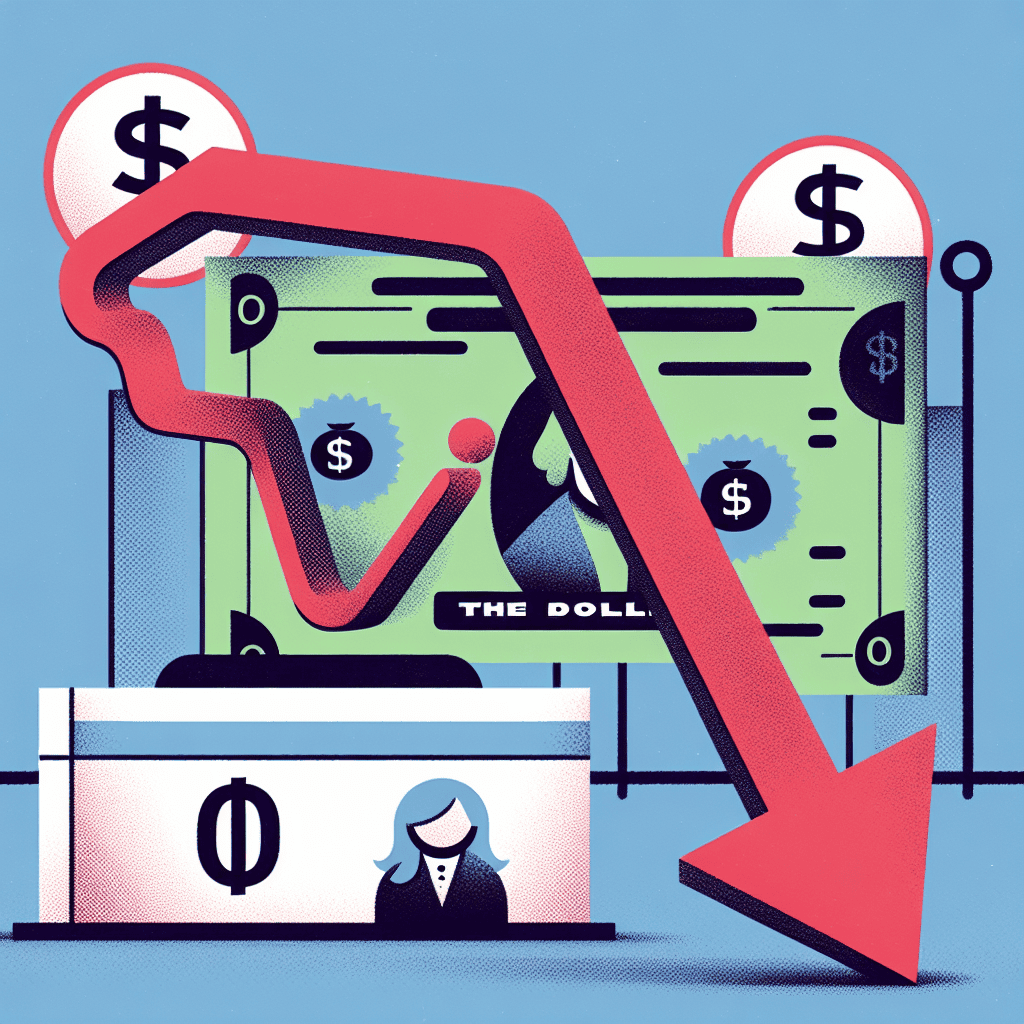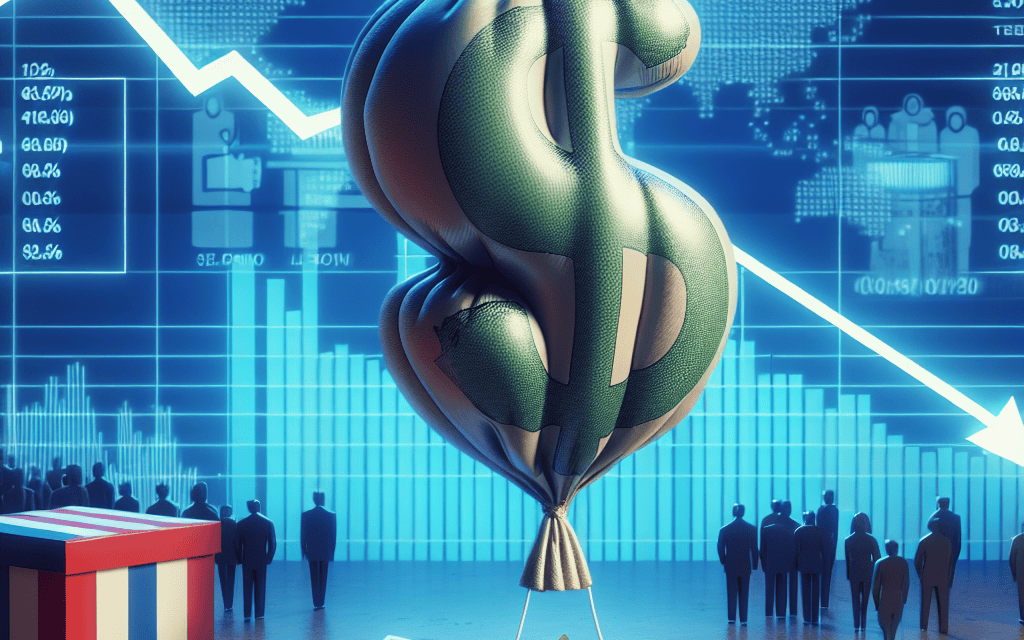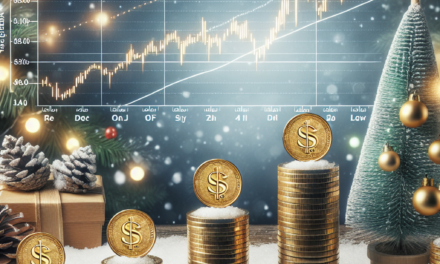“Currency Wavers: Dollar Dips as US Election and Fed Rate Cut Loom”
Introduction
In the wake of the recent U.S. election and growing speculation about a potential interest rate cut by the Federal Reserve, the dollar has experienced a notable dip in value. This decline reflects the market’s response to political uncertainties and economic policy shifts, as investors recalibrate their strategies in anticipation of changes in fiscal and monetary landscapes. The election results have introduced a new wave of unpredictability, influencing currency markets and prompting analysts to reassess the dollar’s trajectory. Concurrently, the possibility of a Fed rate cut looms large, as policymakers weigh the need to stimulate economic growth against the backdrop of evolving domestic and global conditions. These developments underscore the intricate interplay between political events and economic policy, highlighting the dollar’s sensitivity to both national and international influences.
Impact Of US Election On Dollar Value
The value of the US dollar is a critical indicator of the country’s economic health and is closely watched by investors, policymakers, and economists worldwide. Recently, the dollar has experienced a dip, influenced by the ongoing US election and the potential for a Federal Reserve rate cut. These two factors are intricately linked, each playing a significant role in shaping the currency’s trajectory.
The US election, a pivotal event in the political landscape, has historically had a profound impact on the dollar’s value. As candidates present their economic policies, markets react to the perceived implications of these policies on the economy. In the current election cycle, uncertainty surrounding the outcome has contributed to the dollar’s decline. Investors are wary of potential shifts in fiscal policy, trade agreements, and regulatory changes that could arise from a new administration. This uncertainty often leads to increased volatility in currency markets, as traders adjust their positions based on the latest polling data and political developments.
Moreover, the potential for a Federal Reserve rate cut adds another layer of complexity to the dollar’s performance. The Federal Reserve, responsible for setting monetary policy, uses interest rates as a tool to influence economic activity. A rate cut typically aims to stimulate growth by making borrowing cheaper, thereby encouraging spending and investment. However, lower interest rates can also lead to a weaker dollar, as they reduce the returns on investments denominated in the currency. In anticipation of a rate cut, investors may seek higher yields elsewhere, further pressuring the dollar.
The interplay between the US election and the Federal Reserve’s monetary policy is crucial in understanding the dollar’s current dip. As election-related uncertainties persist, the Federal Reserve may feel compelled to act preemptively to support the economy, especially if political developments threaten to disrupt economic stability. This potential for intervention adds to the market’s apprehension, as traders weigh the likelihood of a rate cut against the backdrop of electoral uncertainty.
In addition to these domestic factors, global economic conditions also influence the dollar’s value. The interconnectedness of the global economy means that developments in other major economies can have ripple effects on the US currency. For instance, economic slowdowns in Europe or Asia can lead to increased demand for safe-haven assets like the dollar, temporarily boosting its value. Conversely, strong economic performance abroad can draw investment away from the US, exerting downward pressure on the dollar.
In conclusion, the current dip in the dollar’s value is a multifaceted issue, driven by the intertwined effects of the US election and the potential for a Federal Reserve rate cut. As the election unfolds, market participants will continue to scrutinize political developments and their implications for economic policy. Simultaneously, the Federal Reserve’s actions will be closely monitored for signals of how it intends to navigate the complex economic landscape. Understanding these dynamics is essential for investors and policymakers alike, as they seek to anticipate and respond to the evolving challenges facing the US economy. As such, the dollar’s trajectory remains uncertain, with its future path likely to be shaped by a confluence of domestic and international factors.
Federal Reserve’s Role In Currency Fluctuations
The Federal Reserve plays a pivotal role in influencing currency fluctuations, particularly the value of the US dollar. As the central bank of the United States, the Federal Reserve’s monetary policy decisions, including interest rate adjustments, have far-reaching implications for the global economy. In recent times, the dollar has experienced a dip, a phenomenon closely tied to the ongoing US election and the potential for a Federal Reserve rate cut. Understanding the interplay between these factors is crucial for comprehending the current state of currency markets.
To begin with, the US election introduces a layer of uncertainty that can significantly impact investor sentiment and, consequently, currency values. Elections often bring about policy shifts, and the anticipation of such changes can lead to market volatility. Investors tend to seek safe-haven assets during periods of uncertainty, which can lead to fluctuations in the value of the dollar. As the election approaches, market participants are closely monitoring the political landscape, assessing how potential outcomes might influence economic policies and, by extension, the Federal Reserve’s actions.
In tandem with the election, the Federal Reserve’s monetary policy decisions are a critical factor in currency valuation. The possibility of a rate cut by the Federal Reserve has been a topic of considerable discussion among economists and market analysts. Lowering interest rates typically aims to stimulate economic activity by making borrowing cheaper, thereby encouraging spending and investment. However, such a move can also lead to a depreciation of the currency, as lower interest rates often result in reduced returns on investments denominated in that currency. Consequently, the prospect of a rate cut has contributed to the recent dip in the dollar’s value.
Moreover, the Federal Reserve’s dual mandate of promoting maximum employment and stabilizing prices often necessitates a delicate balancing act. In times of economic uncertainty, such as those brought about by the election, the Federal Reserve may prioritize measures to support economic growth, even if it means accepting a weaker dollar in the short term. This approach underscores the complex relationship between domestic economic objectives and international currency markets.
Additionally, the global context cannot be overlooked when considering the Federal Reserve’s influence on the dollar. The interconnectedness of global economies means that decisions made by the Federal Reserve reverberate beyond US borders. A weaker dollar can have both positive and negative effects on international trade. On one hand, it can make US exports more competitive, potentially boosting the domestic economy. On the other hand, it can increase the cost of imports, contributing to inflationary pressures.
In conclusion, the Federal Reserve’s role in currency fluctuations is multifaceted, with its monetary policy decisions having significant implications for the value of the dollar. The current dip in the dollar, influenced by the US election and the potential for a rate cut, highlights the intricate interplay between political events and economic policy. As the Federal Reserve navigates these challenges, its actions will continue to be closely scrutinized by market participants and policymakers alike. Understanding this dynamic is essential for anyone seeking to grasp the complexities of currency markets and the broader economic landscape.
Historical Trends: Dollar Performance During Elections
The performance of the U.S. dollar during election periods has historically been a subject of keen interest for economists, investors, and policymakers alike. As the world’s primary reserve currency, the dollar’s fluctuations can have far-reaching implications, influencing global trade, investment flows, and economic stability. Historically, the dollar’s performance during U.S. elections has been shaped by a confluence of factors, including political uncertainty, economic policies proposed by candidates, and broader macroeconomic conditions. Understanding these historical trends provides valuable insights into the current scenario, where the dollar is experiencing a dip amid the ongoing U.S. election cycle and speculation about a potential Federal Reserve rate cut.
In past election years, the dollar has often exhibited volatility as markets react to the uncertainty surrounding potential changes in economic policy. For instance, during the 2008 election, the dollar experienced significant fluctuations as the global financial crisis unfolded, and market participants speculated on the economic policies of the incoming administration. Similarly, the 2016 election saw the dollar initially strengthen following the unexpected outcome, driven by expectations of fiscal stimulus and deregulation. However, this was followed by periods of volatility as policy implementation faced hurdles.
Transitioning to the current election cycle, the dollar’s recent dip can be attributed to several interrelated factors. Political uncertainty remains a significant driver, as investors weigh the potential economic implications of different electoral outcomes. The prospect of changes in trade policy, taxation, and government spending can all influence market sentiment and, consequently, the dollar’s value. Moreover, the current election is taking place against a backdrop of heightened geopolitical tensions and economic challenges, further complicating the outlook for the dollar.
In addition to political factors, monetary policy plays a crucial role in shaping the dollar’s performance. The Federal Reserve’s interest rate decisions are particularly influential, as they affect the relative attractiveness of dollar-denominated assets. Historically, periods of monetary easing have often coincided with a weaker dollar, as lower interest rates reduce the yield advantage of holding dollar assets. In the current context, speculation about a potential rate cut by the Federal Reserve is contributing to the dollar’s decline. Market participants are closely monitoring economic indicators and Fed communications for signals about the future path of monetary policy.
Furthermore, the interplay between domestic and international factors cannot be overlooked. The dollar’s status as a global reserve currency means that its performance is also influenced by developments in other major economies. For instance, divergent monetary policies between the Federal Reserve and other central banks can lead to shifts in capital flows, impacting the dollar’s value. Additionally, global economic conditions, such as trade dynamics and commodity prices, can exert pressure on the dollar, either amplifying or mitigating the effects of domestic factors.
In conclusion, the dollar’s performance during U.S. election periods is shaped by a complex interplay of political, economic, and monetary factors. Historical trends highlight the currency’s susceptibility to volatility amid political uncertainty and changing economic policies. In the current election cycle, the dollar’s dip reflects a combination of political uncertainty and expectations of a potential Federal Reserve rate cut. As the election unfolds and economic conditions evolve, the dollar’s trajectory will continue to be closely watched by market participants and policymakers, underscoring its pivotal role in the global financial system.
Potential Rate Cuts: Implications For The US Economy

The recent dip in the value of the US dollar has sparked widespread discussion among economists and financial analysts, particularly in the context of the upcoming US election and the potential for a Federal Reserve rate cut. As the political landscape becomes increasingly uncertain, market participants are closely monitoring how these factors might influence the broader US economy. The interplay between political events and monetary policy decisions is complex, yet understanding their potential implications is crucial for stakeholders across various sectors.
To begin with, the US election introduces a layer of unpredictability that can significantly impact investor sentiment. Historically, elections have been periods of heightened volatility in financial markets, as investors attempt to anticipate the economic policies of potential new administrations. This uncertainty often leads to fluctuations in currency values, with the dollar being no exception. As candidates outline their economic agendas, market participants weigh the potential impacts on trade, fiscal policy, and regulatory environments, all of which can influence the dollar’s strength.
Simultaneously, the Federal Reserve’s monetary policy decisions are under intense scrutiny. The possibility of a rate cut looms large, as the Fed seeks to navigate a challenging economic landscape marked by inflationary pressures and uneven growth. A rate cut, typically aimed at stimulating economic activity by making borrowing cheaper, could have several implications for the US economy. On one hand, it might provide a much-needed boost to consumer spending and business investment, potentially offsetting some of the economic headwinds. On the other hand, lower interest rates could exacerbate inflationary trends, complicating the Fed’s dual mandate of promoting maximum employment and stable prices.
Moreover, a rate cut could influence the dollar’s value on the global stage. Generally, lower interest rates tend to make a currency less attractive to foreign investors seeking higher returns, leading to a depreciation of the currency. A weaker dollar can have mixed effects on the US economy. For exporters, a depreciated dollar can be beneficial, as it makes American goods more competitive abroad, potentially boosting export-driven sectors. However, for importers and consumers, a weaker dollar can lead to higher prices for imported goods, contributing to inflationary pressures.
In addition to these direct economic impacts, the potential rate cut and its effects on the dollar must be considered within the broader context of global economic dynamics. The interconnectedness of global markets means that shifts in US monetary policy can have ripple effects worldwide. Emerging markets, in particular, may experience capital flow volatility as investors adjust their portfolios in response to changing interest rate differentials. This could lead to financial instability in regions heavily reliant on foreign investment.
In conclusion, the potential for a Federal Reserve rate cut amid the backdrop of the US election presents a multifaceted challenge for the US economy. While the immediate effects on the dollar and domestic economic activity are of primary concern, the broader implications for global financial stability cannot be overlooked. As policymakers and market participants navigate this uncertain terrain, careful consideration of both domestic and international factors will be essential in crafting strategies that promote sustainable economic growth. The coming months will undoubtedly be pivotal in shaping the economic landscape, with the interplay between political developments and monetary policy decisions playing a central role in determining the trajectory of the US economy.
Investor Strategies Amid Dollar Volatility
As the U.S. dollar experiences fluctuations amid the ongoing election cycle and speculation surrounding potential Federal Reserve rate cuts, investors are keenly observing the currency markets to adjust their strategies accordingly. The dollar’s recent dip has been influenced by a confluence of political and economic factors, prompting investors to reassess their portfolios in light of these developments. Understanding the implications of these factors is crucial for investors aiming to navigate the current volatility effectively.
The U.S. election cycle often brings a degree of uncertainty to financial markets, and this year is no exception. Political campaigns and debates can lead to shifts in investor sentiment, as market participants attempt to anticipate the potential economic policies of future administrations. This uncertainty can result in increased volatility in the currency markets, with the dollar being particularly susceptible to fluctuations. As candidates outline their economic agendas, investors must remain vigilant, analyzing how proposed policies might impact the dollar’s strength and, consequently, their investment strategies.
Simultaneously, the Federal Reserve’s monetary policy decisions play a pivotal role in influencing the dollar’s trajectory. Speculation about potential rate cuts has added another layer of complexity to the current market environment. Lower interest rates typically reduce the appeal of holding dollars, as they offer lower returns compared to other currencies with higher interest rates. Consequently, investors are closely monitoring the Fed’s communications and economic indicators that might signal a shift in monetary policy. By staying informed about these developments, investors can better position themselves to capitalize on or mitigate the effects of any potential rate adjustments.
In light of these factors, investors are exploring various strategies to manage the risks associated with dollar volatility. Diversification remains a fundamental approach, as spreading investments across different asset classes and geographic regions can help mitigate the impact of currency fluctuations. By holding a mix of domestic and international assets, investors can reduce their exposure to any single currency’s movements, thereby enhancing the resilience of their portfolios.
Moreover, some investors are turning to hedging strategies to protect against adverse currency movements. Utilizing financial instruments such as options and futures contracts can provide a level of insurance against unfavorable shifts in the dollar’s value. These tools allow investors to lock in exchange rates or offset potential losses, offering a degree of stability in uncertain times. However, it is essential for investors to carefully assess the costs and benefits of such strategies, as they can be complex and may not be suitable for all portfolios.
Additionally, investors are increasingly considering the role of emerging markets in their strategies. As the dollar weakens, emerging market currencies may become more attractive, offering potential opportunities for growth. However, investing in these markets requires a thorough understanding of the associated risks, including political instability and economic volatility. By conducting comprehensive research and due diligence, investors can identify promising opportunities while managing the inherent risks.
In conclusion, the current environment of dollar volatility, driven by the U.S. election and potential Federal Reserve rate cuts, presents both challenges and opportunities for investors. By staying informed and adopting a proactive approach, investors can navigate these uncertainties and adjust their strategies to align with their financial goals. Whether through diversification, hedging, or exploring emerging markets, a well-considered strategy can help investors manage risks and capitalize on potential opportunities in this dynamic landscape.
Global Market Reactions To US Political Events
The global financial markets are once again under the microscope as the United States navigates a complex political landscape, with the dollar experiencing a notable dip amid the ongoing election cycle and speculation surrounding potential Federal Reserve rate cuts. As investors worldwide keep a close watch on these developments, the interplay between political events and economic policy decisions is becoming increasingly evident, influencing market dynamics in profound ways.
To begin with, the US election cycle has historically been a period of heightened volatility in financial markets, and the current scenario is no exception. As candidates vie for political power, their proposed policies and potential impacts on the economy are scrutinized by investors. This scrutiny often leads to fluctuations in the value of the dollar, as market participants adjust their positions based on perceived risks and opportunities. In this context, the dollar’s recent dip can be attributed to the uncertainty surrounding the election outcomes and the potential shifts in economic policy that could follow.
Moreover, the Federal Reserve’s monetary policy decisions are playing a crucial role in shaping market reactions. With inflationary pressures persisting and economic growth showing signs of moderation, there is growing speculation that the Fed may consider cutting interest rates to stimulate the economy. Such a move would likely lead to a depreciation of the dollar, as lower interest rates tend to reduce the currency’s appeal to investors seeking higher returns. Consequently, the anticipation of a potential rate cut is contributing to the dollar’s current weakness.
In addition to these domestic factors, global market reactions are also being influenced by international considerations. The interconnectedness of the global economy means that US political events and monetary policy decisions have far-reaching implications. For instance, a weaker dollar can lead to increased competitiveness for US exports, benefiting American businesses but potentially creating challenges for trading partners. Conversely, countries with currencies pegged to the dollar may experience economic strain as they navigate the impacts of a depreciating US currency.
Furthermore, the dollar’s dip is prompting central banks and policymakers around the world to reassess their strategies. In some cases, countries may intervene in foreign exchange markets to stabilize their own currencies, while others might adjust their monetary policies to mitigate the effects of a weaker dollar. These actions, in turn, contribute to the complex web of global market reactions, highlighting the intricate relationship between US political events and international economic dynamics.
As the US election cycle progresses and the Federal Reserve’s policy decisions unfold, market participants will continue to monitor these developments closely. The interplay between political uncertainty and economic policy will remain a key driver of market sentiment, influencing investment decisions and shaping the trajectory of the global economy. In this environment, investors are likely to adopt a cautious approach, seeking to balance potential risks with opportunities for growth.
In conclusion, the dollar’s recent dip amid the US election and potential Fed rate cut underscores the significant impact of political events and monetary policy on global markets. As these factors continue to evolve, their influence on market dynamics will be closely watched by investors and policymakers alike. The interconnected nature of the global economy ensures that developments in the United States will reverberate across borders, shaping the financial landscape in the months to come.
Comparing Past And Present: Dollar Dips In Election Years
The value of the U.S. dollar often experiences fluctuations during election years, a phenomenon that has been observed throughout history. As the nation approaches another pivotal election, the dollar has once again shown signs of dipping, a trend that can be attributed to a combination of political uncertainty and economic policy shifts. This year, the potential for a Federal Reserve rate cut adds another layer of complexity to the currency’s performance, drawing parallels to past election cycles while also presenting unique challenges.
Historically, election years in the United States have been marked by heightened volatility in financial markets, with the dollar frequently caught in the crosscurrents of political and economic forces. Investors, wary of the potential for policy changes that could impact economic growth, often adopt a cautious stance, leading to fluctuations in the currency’s value. For instance, during the 2008 election, the dollar experienced significant volatility as the global financial crisis unfolded, prompting concerns about the future direction of U.S. economic policy.
In the current election cycle, the dollar’s dip can be attributed to several factors. Political uncertainty remains a significant driver, as investors grapple with the potential outcomes of the election and their implications for fiscal and monetary policy. The prospect of a change in administration or shifts in congressional power can lead to speculation about future economic policies, influencing investor sentiment and, consequently, the value of the dollar.
Moreover, the Federal Reserve’s monetary policy plays a crucial role in shaping the dollar’s trajectory. In recent months, there has been growing speculation about the possibility of a rate cut by the Fed, aimed at stimulating economic growth amid signs of a slowing economy. Such a move would likely exert downward pressure on the dollar, as lower interest rates tend to make a currency less attractive to investors seeking higher returns. This potential rate cut echoes past instances where the Fed has adjusted its policy in response to economic conditions during election years, further contributing to the dollar’s volatility.
Comparing the present situation to past election years, it is evident that while the underlying dynamics remain similar, the specific circumstances and challenges differ. For example, the global economic landscape has evolved significantly, with factors such as international trade tensions and geopolitical risks playing a more prominent role in influencing currency markets. Additionally, the unprecedented impact of the COVID-19 pandemic has introduced new variables into the equation, affecting both domestic and global economic conditions.
Despite these differences, the interplay between political uncertainty and monetary policy continues to be a defining feature of the dollar’s performance in election years. As investors navigate this complex environment, they must weigh the potential outcomes of the election against the backdrop of evolving economic conditions and policy responses. This delicate balancing act underscores the importance of understanding the historical context while remaining attuned to the unique challenges of the present.
In conclusion, the dollar’s dip amid the U.S. election and potential Fed rate cut highlights the intricate relationship between political events and economic policy. By examining past election years, we gain valuable insights into the factors that drive currency fluctuations, while also recognizing the distinct challenges of the current landscape. As the election approaches, the dollar’s performance will continue to be closely monitored, serving as a barometer of investor sentiment and economic expectations in an ever-changing world.
Q&A
1. **What is causing the dollar to dip amid the US election?**
Uncertainty surrounding the US election results can lead to market volatility, causing investors to move away from the dollar as they seek safer assets.
2. **How do US elections typically impact the dollar?**
US elections can create uncertainty in financial markets, often leading to fluctuations in the dollar’s value as investors react to potential changes in economic policy.
3. **What role does the Federal Reserve play in the dollar’s value?**
The Federal Reserve influences the dollar’s value through its monetary policy decisions, including interest rate adjustments, which can affect investor confidence and currency strength.
4. **Why might the Federal Reserve consider a rate cut?**
The Federal Reserve might consider a rate cut to stimulate economic growth, especially if there are signs of economic slowdown or to counteract negative impacts from political uncertainty.
5. **How does a potential Fed rate cut affect the dollar?**
A potential Fed rate cut can weaken the dollar as lower interest rates make US assets less attractive to investors, leading to reduced demand for the currency.
6. **What are the broader economic implications of a weaker dollar?**
A weaker dollar can boost US exports by making them cheaper for foreign buyers, but it can also increase the cost of imports and contribute to inflationary pressures.
7. **How do investors typically respond to a weaker dollar and potential rate cuts?**
Investors may shift their portfolios towards assets denominated in other currencies or seek safe-haven investments like gold, which can lead to further depreciation of the dollar.
Conclusion
The recent dip in the US dollar can be attributed to the uncertainty surrounding the US election and the potential for a Federal Reserve rate cut. As investors navigate the political landscape and economic indicators, the dollar’s value has been pressured by expectations of a more accommodative monetary policy. A rate cut by the Fed would typically lead to a weaker dollar, as lower interest rates make the currency less attractive to investors seeking higher returns. Additionally, the election introduces further volatility, as market participants assess the potential impact of different policy outcomes on the economy. In conclusion, the interplay between political uncertainty and monetary policy expectations is driving the current weakness in the dollar, highlighting the complex dynamics influencing currency markets.





